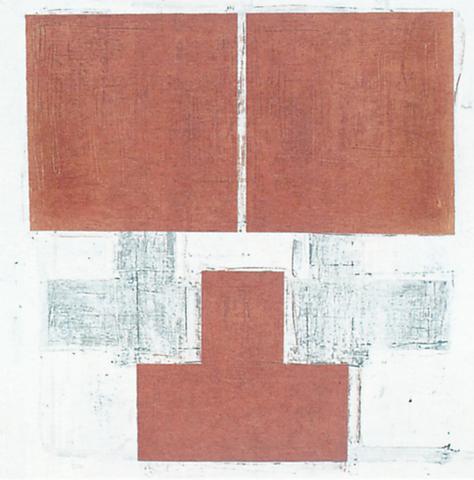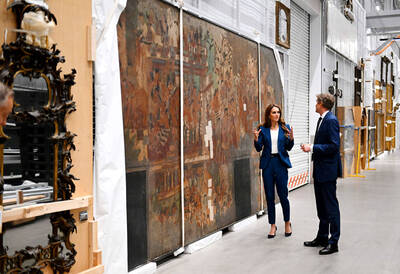Lai Chiu-chen (
A cursory look at Lai's dozens of uniformly sized paintings might leave you wondering what the judges of the Taipei Arts Awards had in mind when handing the prize to Lai. The dozens of 60cm-square portraits elicit lackluster curiosity which most viewers articulate as "what is it?" Each of the paintings surely seem to be of something, but lack a completeness of identity if only because we the viewers have never seen them before. Or have we?

What Lai, an avid toy collector, has painted are pieces of busted apart toys -- the kinds of things that might be swept off the kindergarten floor at the end of the day or that make their way behind the dresser in a child's bedroom: the head of a plastic doll, a robot arm, a non-descript piece of plastic with a spring attached and other widgets that have come apart at the seams. They're piled in three small Lucite boxes at the exhibit's entrance and are worth studying twice.

The initial study is to demonstrate how little you think you know. Where, for instance does the painting of the one-eyed doll come from? It's not in the box. But it is. We assume that the doll's head seen in the Lucite box would be painted as it might look atop the doll's body. But a second look shows that Lai has painted it instead as it might be seen on lying on the floor, looking down the neck.
It's an interesting study in still-life that every art student must do; "paint what you see." Lai, however, has taken it a step further and given his tiny obscure subjects identities of their own beyond their erstwhile identities of "doll's head" or "robot's arm".

"When these incomplete parts appear in a painting they become a complete whole," Lai said. "This is a kind of metamorphosis, where the entire body goes from being a whole to a series of parts back to becoming whole again."

For Lai, the study is philosophically self-referential. "One may see this exhibition as a cognitive painting game," Lai says. "Is the abstract hiding in the
concrete or is the concrete hiding in the abstract, or is the concrete hidden in another concrete? ? When viewers find the concrete hidden in the painting, do they understand the painting? Is this the object that they are looking for? Perhaps all of this can begin at the entrance of the exhibition."

Maybe it's worth studying those broken toy parts a third time.

Parts of Toys runs now through Feb. 15 at the Taipei Fine Arts Museum, located at 181 Zhongshan N Rd, Sec 3 in Taipei City (

June 9 to June 15 A photo of two men riding trendy high-wheel Penny-Farthing bicycles past a Qing Dynasty gate aptly captures the essence of Taipei in 1897 — a newly colonized city on the cusp of great change. The Japanese began making significant modifications to the cityscape in 1899, tearing down Qing-era structures, widening boulevards and installing Western-style infrastructure and buildings. The photographer, Minosuke Imamura, only spent a year in Taiwan as a cartographer for the governor-general’s office, but he left behind a treasure trove of 130 images showing life at the onset of Japanese rule, spanning July 1897 to

One of the most important gripes that Taiwanese have about the Democratic Progressive Party (DPP) is that it has failed to deliver concretely on higher wages, housing prices and other bread-and-butter issues. The parallel complaint is that the DPP cares only about glamor issues, such as removing markers of Chinese Nationalist Party (KMT) colonialism by renaming them, or what the KMT codes as “de-Sinification.” Once again, as a critical election looms, the DPP is presenting evidence for that charge. The KMT was quick to jump on the recent proposal of the Ministry of the Interior (MOI) to rename roads that symbolize

On the evening of June 1, Control Yuan Secretary-General Lee Chun-yi (李俊俋) apologized and resigned in disgrace. His crime was instructing his driver to use a Control Yuan vehicle to transport his dog to a pet grooming salon. The Control Yuan is the government branch that investigates, audits and impeaches government officials for, among other things, misuse of government funds, so his misuse of a government vehicle was highly inappropriate. If this story were told to anyone living in the golden era of swaggering gangsters, flashy nouveau riche businessmen, and corrupt “black gold” politics of the 1980s and 1990s, they would have laughed.

Imagine being able to visit a museum and examine up close thousand-year-old pottery, revel alone in jewelry from centuries past, or peer inside a Versace bag. Now London’s V&A has launched a revolutionary new exhibition space, where visitors can choose from some 250,000 objects, order something they want to spend time looking at and have it delivered to a room for a private viewing. Most museums have thousands of precious and historic items hidden away in their stores, which the public never gets to see or enjoy. But the V&A Storehouse, which opened on May 31 in a converted warehouse, has come up